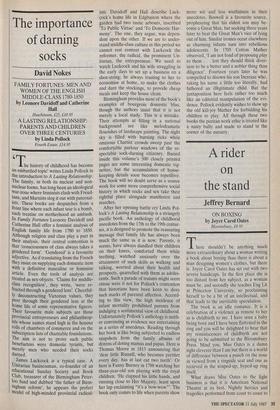The importance of darning socks
David Nokes
FAMILY FORTUNES: MEN AND WOMEN OF THE ENGLISH MIDDLE-CLASS 1780-1850 by Leonore Davidoff and Catherine Hall
Hutchinson, £25, £10.95
A LASTING RELATIONSHIP: PARENTS AND CHILDREN OVER THREE CENTURIES by Linda Pollock
Fourth Estate, £14.95
The history of childhood has become an embattled topic' writes Linda Pollock in the introduction to A Lasting Relationship. The family, in both its nuclear and non- nuclear forms, has long been an ideological war-zone where feminists clash with Freud- ians, and Marxists slog it out with paternal- ists. These books are despatches from a front line where each infant tear is a bomb, each treatise on motherhood an ambush. In Family Fortunes Leonore Davidoff and Catherine Hall offer a feminist analysis of English family life from 1780 to 1850. Although religion and class play a part in their analysis, their central contention is that 'consciousness of class always takes a gendered form'. `Gendered' is a favourite adjective. As if translating from the French they insist on supplying each domestic item With a definitive masculine or feminine article. Even the tools of analysis are treated as sex-objects. 'Claims for middle- class recognition', they write, 'were re- fracted through a gendered lens'. Cheerful- ly deconstructing Victorian values, they peer through their gendered lens at the home life of some representative figures. Their favourite male subjects are those Provincial entrepreneurs and philanthrop- ists whose names stand high in the honour rolls of chambers of commerce and on the subscription lists of charitable foundations. The aim is not to prove such public benefactors were domestic tyrants, but merely men who needed their socks darned.
James Luckcock is a typical case. A Unitarian businessman, co-founder of an educational Sunday Society and Book Club, treasurer of the Birmingham Peter- too fund and dubbed 'the father of Birm- ingham reform', he appears the perfect model of high-minded provincial radical-
ism. Davidoff and Hall describe Luck- cock's home life in Edgbaston where the garden had two rustic arbours, inscribed 'To Public Virtue' and 'To Domestic Har- mony'. The one, they argue, was depen- dent upon the other. If we are to under- stand middle-class culture in this period we cannot rest content with Luckcock the reformer, the radical, the prominent Un- itarian, the entrepreneur. We need to watch Luckcock and his wife struggling in the early days to set up a business on a shoe-string; he always trusting to her to economise at home, to make the clothes and darn the stockings, to provide cheap meals and keep the house clean.
Birmingham provides most of the book's examples of bourgeois domestic bliss, though the authors insist that it is not merely a local study. This is a mistake. Their attempts at filling in a national background are like melodramatic flourishes of landscape painting. The night sky is filled with burning ricks while ominous Chartist crowds sweep past the comfortable parlour windows of the re- spectable sock-darning citizenry. Buried inside this volume's 500 closely printed pages are some interesting domestic vig- nettes, but the accumulation of house- keeping details soon becomes repetitive. The book will no doubt serve as a source work for some more comprehensive social history in which socks and sex take their rightful place alongside manifestos and marches.
After her opening battle cry Linda Pol- lock's A Lasting Relationship is a strangely pacific book. An anthology of childhood anecdotes from the 17th to the 19th centur- ies, it is designed to promote the reassuring message that family life has always been much the same as it is now. Parents, it seems, have always dandled their children on their knees, comforted them while teething, watched anxiously over the attainment of such skills as walking and talking, worried about their health and prospects, quarrelled with them as adoles- cents. Such a parade of truisms might seem otiose were it not for Pollock's contention that historians have been keen to deny such marks of parental affection. Accord- ing to this view, the high incidence of infant mortality prohibited parents from indulging a sentimental view of childhood. Unfortunately Pollock's anthology is neith- er convincing as evidence nor entertaining as a series of anecdotes. Reading through her book is like being subjected to endless snapshots from the family albums of dozens of doting mamas and papas. Here is Thomas Moore in 1813 announcing that 'dear little Russell, who becomes prettier every day, has at last cut two teeth'. Or here is Fanny Burney in 1798 watching her three-year-old son playing with the royal children: 'He clapped his little hands, and running close to Her Majesty, leant upon her lap exclaiming "it's a bow-wow". The book only comes to life when parents show more wit and less wistfulness in their anecdotes. Boswell is a favourite source, prophesying that his eldest son may be- come a Great Man, but seeking three years later to beat the Great Man's vice of lying out of him. Similar ironies occur elsewhere as charming infants turn into rebellious adolescents. In 1705 Cotton Mather observed, 'I am not fond of proposing play to them . . . lest they should think diver- sion to be a better and a nobler thing than diligence'. Fourteen years later he was compelled to disown his son Increase who, taking his name a little too literally, had fathered an illbgitimate child. But the juxtaposition here feels rather too much like an editorial, manipulation of the evi- dence. Pollock evidently wishes to show up the old kill-joy Mather for forbidding his children to play. All through these two books the puritan work ethic is treated like a nasty bully and made to stand in the corner of the nursery.


















































 Previous page
Previous page